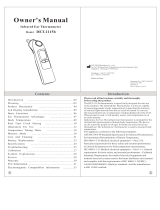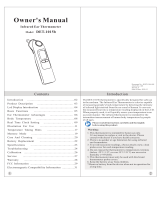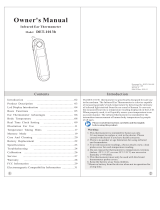
Illustration For Use
Illustration For Use
14
Illustration For Use
Figure 4
X
√
3. Insert the probe along the ear canal as deep as possible into the
ear as depicted in Figure 4. Then press the Test BUTTON once
to start the measurement. A long beep will sound approximately
1 second after the Test BUTTON is activated. This signals the
end of the process as results are displayed on the LCD screen.
4. The thermometer is ready for testing again once an ear mark
displays on the LCD. A waiting period of 20 seconds between
testing is recommended to avoid excessive cooling of the skin.
5. The thermometer will shut off automatically after 60 seconds
of inactivity. To prolong battery life, press Button to turn
the unit off.
13
12
11
Real Time Clock Setting
④ Set the minute
Press and release the Button to advance
one minute until the correct minute appears.
After the minute is set, press Setting Button, the Year
figure is flashing automatically.
⑤ Set the year
Press and release the Button to advance
one year until the correct year appears.
After the year is set, press Setting Button, the Month
figure will appear.
⑥ Set the month
Press and release the Button to advance
one month until the correct month appears.
After the month is set, press Setting Button, the Date
figure is flashing automatically.
⑦ Set the date
Press and release the Button to advance
one day until the correct month appears.
After the day is set, press Setting Button to exit the
setting mode.
sure a new, clean probe cover is in place before each
measurement. Place a new probe cover on the probe firmly;
making sure the probe and the inner portion of the probe cover
fit snugly.
2. Press the , The display is activated to show all
segments. After self-checking Figure 2 appears on the display
screen , and three lines appear in the center of the screen
successively, then you can start a new measurement. If error
messages appears, it means the thermometer is not ready for
measurement.
Remarks:
a. Probe cover sign stand for taking the ear temperature with
probe cover now and vice versa.DET-1215b must be used with
probe cover, if not installed with probe cover, then “CAP”
appears on the display(as shown in Figure 3)
b. To avoid the risk of cross contamination, it is recommended
that you always measure the ear temperature with probe cover.
1. To achieve accurate readings, if a probe cover is needed ,make
Button
To measure ear temperature:
Figure 2
How to turn on or off sound:
You can press Setting Button to turn on or off sound.
After measurement:
1. Power off:
Device will automatically shut off if left idle for
more than 1 minute to extend battery life.
2. Clean the probe after each use to ensure an accurate reading and
avoid cross contamination.
(See the section of Care and Cleaning for details.)
●
● Press Button to turn it off .
Figure 3
BackLight:
In Ear mode:
1. The display will be lighted GREEN for 3 seconds with a happy
face when the unit is ready for measurement and a measurement
is completed with a reading less than 37.3 (99.1 ).
2. The display will be lighted YELLOW for 3 seconds with a happy
face when a measurement is completed with a reading less than
37.8℃(100.0 ).
3. The display will be lighted RED for 3 seconds with a bad face
when a measurement is completed with a reading equal to or higher
than 37.8℃(100.0 ).
℃℉
℉
℉
Figure12
Figure 11
















